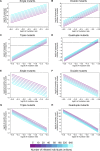Risk of rapid evolutionary escape from biomedical interventions targeting SARS-CoV-2 spike protein
- PMID: 33909660
- PMCID: PMC8081162
- DOI: 10.1371/journal.pone.0250780
Risk of rapid evolutionary escape from biomedical interventions targeting SARS-CoV-2 spike protein
Abstract
The spike protein receptor-binding domain (RBD) of SARS-CoV-2 is the molecular target for many vaccines and antibody-based prophylactics aimed at bringing COVID-19 under control. Such a narrow molecular focus raises the specter of viral immune evasion as a potential failure mode for these biomedical interventions. With the emergence of new strains of SARS-CoV-2 with altered transmissibility and immune evasion potential, a critical question is this: how easily can the virus escape neutralizing antibodies (nAbs) targeting the spike RBD? To answer this question, we combined an analysis of the RBD structure-function with an evolutionary modeling framework. Our structure-function analysis revealed that epitopes for RBD-targeting nAbs overlap one another substantially and can be evaded by escape mutants with ACE2 affinities comparable to the wild type, that are observed in sequence surveillance data and infect cells in vitro. This suggests that the fitness cost of nAb-evading mutations is low. We then used evolutionary modeling to predict the frequency of immune escape before and after the widespread presence of nAbs due to vaccines, passive immunization or natural immunity. Our modeling suggests that SARS-CoV-2 mutants with one or two mildly deleterious mutations are expected to exist in high numbers due to neutral genetic variation, and consequently resistance to vaccines or other prophylactics that rely on one or two antibodies for protection can develop quickly -and repeatedly- under positive selection. Predicted resistance timelines are comparable to those of the decay kinetics of nAbs raised against vaccinal or natural antigens, raising a second potential mechanism for loss of immunity in the population. Strategies for viral elimination should therefore be diversified across molecular targets and therapeutic modalities.
Conflict of interest statement
I have read the journal’s policy and the authors of this manuscript have the following competing interests: A.C., M.S., and U.T. are employees and shareholders of Fractal Therapeutics. D.V.E., A.N., B.Z., and D.J.- M. are shareholders of Fractal Therapeutics. This does not alter our adherence to PLOS ONE policies on sharing data and materials.
Figures





References
-
- CDC. How Flu Viruses Can Change. In: Centers for Disease Control and Prevention [Internet]. 15 October 2019. [cited 8 Nov 2020]. Available: https://www.cdc.gov/flu/about/viruses/change.htm.
-
- To KK-W, Tsang OT-Y, Leung W-S, Tam AR, Wu T-C, Lung DC, et al.. Temporal profiles of viral load in posterior oropharyngeal saliva samples and serum antibody responses during infection by SARS-CoV-2: an observational cohort study. The Lancet Infectious Diseases. 2020;20: 565–574. 10.1016/S1473-3099(20)30196-1 - DOI - PMC - PubMed
Publication types
MeSH terms
Substances
LinkOut - more resources
Full Text Sources
Other Literature Sources
Medical
Miscellaneous

